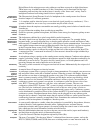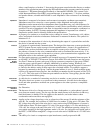
Glossary137
Film-Style
Directing
Directing separate takes or scenes that are to be later edited in postproduction. These takes or
scenes are not necessarily in the same sequence as they will appear in the film or tape.
FM
Frequency Modulation. A method of adding audio to a radio frequency carrier. FM signals are
usually more noise free than amplitude modulation (AM) signals. Wireless intercom units usually
use FM.
Follow Spot
Used to accent or light action on stage, the follow spot is a focused high power light that focuses a
beam from a large circle to a small spot. The operator of the follow spot is usually on the lighting
intercom line, and sometimes in small productions on the primary intercom line. The follow spot
operators have been known to tape their beltpack to the spotlight or a nearby metal structure. This
practice can cause hum and noise in the intercom line because of the large currents involved in
lighting. Some of the currents are induced into the metallic structure of the facility causing large
“ground” currents. If a belt pack is to be taped to something, a layer of tape should be put around
the belt pack first to insulate it from any metal. The newer BP325 has a nonmetallic case, so
adding tape to the case is unnecessary, but it is necessary to prevent contact of connector shells
and other metal objects with ground or metallic structures.
Four-Wire
A communications system where the path is different for talk and listen. In electrical pathways
there are, in fact, four wires (two paths). Four-wire systems can be four- wire balanced and four-
wire unbalanced.
Four-Wire
Balanced
Four-wire balanced is similar to four-wire unbalanced except that conductors are not tied to
circuit common. Circuit common is either tied to a transformer center tap, or is an electrical center
point, or not tied at all.
Four-Wire
Unbalanced
A four-wire system that uses a circuit common and two additional conductors. The talk pathway
consists of one conductor plus circuit common. The listen pathway consists of another conductor
and circuit common.
Full Duplex
Duplex communication allows simultaneous two-way conversations, that is one person can
interrupt the other. In data communications, full duplex permits confirmation of sent data by the
receiving terminal echoing or sending back the same data or confirming data.
Frequency
The number of times per second a periodic action occurs. Frequency is measured in Hertz
(formerly cycles per second).
Frequency
Response
The range of useful frequencies for a particular device, circuit, or system. For example: a
microphone frequency response of 20 Hertz to 20,000 Hertz ±3 dB would be considered
excellent. The design goal of the TW system is 75 Hertz to 20,000 Hertz (system), 75 Hertz to
10,000 Hertz (microphone preamplifier), and 75 Hertz to 8,000 Hertz (headphone/speaker
amplifiers). The response on an actual system will vary according to the amount of cable in the
system, various trade-offs, and the number of stations in the system.
G
Gain
1. Level of amplification for audio/video signals. Operators may need to periodically adjust these
levels during production (especially those gain controls on the audio mixer board). 2. An
important parameter of a functional block or a circuit device. The gain is the output voltage
divided by the input voltage, the output current divided by the input current, or the output power
divided by the input power. For example: a microphone preamplifier in a TW user station may
have a maximum gain of 54 dB (a voltage ratio of 500). Note that, in the case of the bilateral
current source, it is a voltage controlled current source, and is characterized not by gain, but by
transconductance. Transconductance is given by the output amperes divided by the input volts.
The units of transconductance are siemens (formerly the units were mhos). The bilateral current
source used in RTS™ Systems user stations usually has a transconductance of 5 milliamperes
divided by 1.5 volts or 3.3 millisiemens.
GND
An abbreviation for ground.
GPIO
General Purpose Input / Output. (You may also see this referred to simply as “GPI”.) GPIO is a
means of controlling devices using switch contact closures, DC voltages, or similar methods. For
example: you can control a lighting system from keypanel keys, or key a transmitter from a talk
key during transmit. Or, simply operate a light or buzzer for cueing. In ADAM™, ADAM™ CS,


















